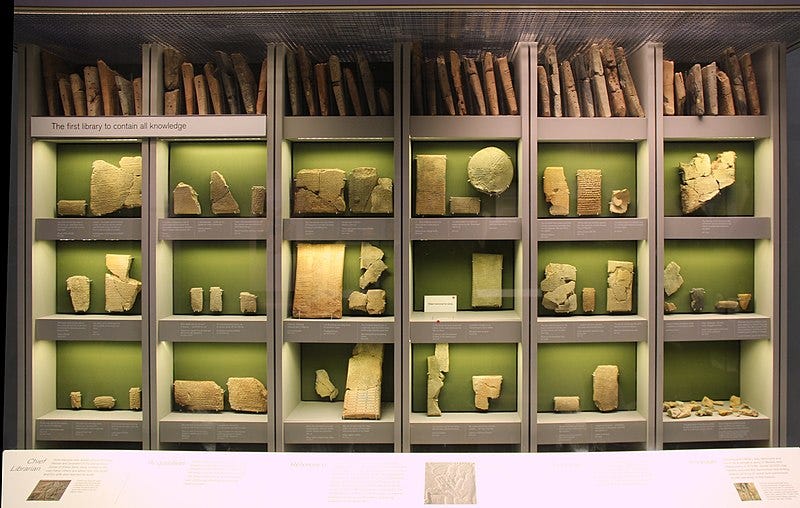The Legacy of the Ancient World's Grandest Library
Written on
Chapter 1: The Library Before Alexandria
The Library of Ashurbanipal, housing over 30,000 texts, is believed to have inspired the famed Library of Alexandria.

In 1849, the English explorer Austen Henry Layard made a groundbreaking discovery of clay tablets in Nineveh's ruins, once a thriving center of the Assyrian Empire. Three years later, his colleague Hormuzd Rassam uncovered even more tablets, leading to the revelation of one of the largest libraries from antiquity: the Library of King Ashurbanipal.
This library is thought to have significantly influenced the renowned Library of Alexandria, a pivotal hub for knowledge and a birthplace for numerous discoveries. Ashurbanipal, who ruled from 669 to 631 B.C., was known not only for his military conquests but also for his profound thirst for knowledge, amassing all available texts by any means necessary.
What drove this formidable conqueror's relentless quest for understanding? To answer this, we need to examine the evolution of libraries throughout history.
Section 1.1: The Origins of Libraries
Why did societies establish libraries? Initially, they served as archives for tax records and trade agreements, reflecting the increasing commerce among diverse cultures that necessitated writing.
Archaeological findings in Ebla, Syria, revealed the earliest known collection of documents, the Ebla tablets, dating back 4,500 years. This collection includes approximately 1,800 complete clay tablets and numerous fragments, documenting various aspects of life, from business dealings to religious rituals.
Hattusa, the capital of the Hittite Empire in modern-day Turkey, boasted the first significant organized library, containing over 25,000 texts. This collection, now referred to as the Bogazkoy archive, included legal documents, religious edicts, and mythological narratives, primarily written in Hittite.
Section 1.2: The Library of Ashurbanipal: A Cultural Beacon
The ancient civilizations of Mesopotamia initiated libraries for record-keeping, gradually incorporating royal decrees and sacred writings. In those times, diviners held considerable sway, believed to possess the ability to predict future events. They were regarded as knowledgeable individuals who understood celestial patterns and human behavior, akin to ancient astrologers.
By the end of the third millennium B.C., religious texts in Sumerian and Akkadian were widely circulated, serving as authoritative guides for rulers seeking to legitimize their power through divine endorsement. The Assyrian Empire, which dominated a diverse range of territories, relied heavily on these divine scriptures, especially during times of rebellion.
The first library of the Assyrian Empire may have been established by Sargon II (722-705 B.C.) in his brief capital, Durr-Sharrukin. However, it was his grandson, Esarhaddon, who significantly expanded this quest for knowledge. He summoned scribes and religious leaders from across the empire to report to scholars in Nineveh.
This video explores the History of the Library of Alexandria, often referred to as the Wikipedia of the ancient world, and its significant influence on knowledge preservation.
Ashurbanipal’s reign marked a turning point, as he had the ability to read—a rarity among royalty of that era. Following the Assyrian conquest of Babylon in 689 B.C., tensions rose between the two cultures. Esarhaddon, aware of the Babylonians' extensive literary heritage, sought copies of their texts rather than originals. Yet Ashurbanipal was unwavering in his determination, acquiring valuable manuscripts from Southern Mesopotamia, often through force.
This video delves into the Real History of the Library of Alexandria, shedding light on its legacy and the cultural exchanges it fostered.
Ashurbanipal's library ultimately contained over 30,000 tablets, solidifying its status as the most extensive library of the ancient world before Alexandria emerged. His collection included legal documents, literary works, and religious texts, with the Epic of Gilgamesh being the most notable. This epic tale, recounting the adventures of the legendary king Gilgamesh, has profoundly influenced literature globally, including biblical narratives.
The tablets, primarily in Akkadian and Babylonian, were meticulously categorized, akin to modern libraries. This systematization was crucial for the preservation of knowledge, as the library faced destruction when Nineveh was sacked in 612 B.C. The fire that consumed it, however, inadvertently helped preserve many tablets through baking.
Despite its eventual destruction, the Library of Ashurbanipal remains a testament to the intellectual achievements of its time. Archaeological efforts continue, with the British Museum collaborating with the University of Mosul since 2002 to reconstruct and document the library's extensive history.
Chapter 2: The First Peace Treaty in Human History
The first documented peace treaty, signed in 1258 B.C., marked the end of hostilities between two powerful Bronze Age nations.
References:
Murray, Stuart A.P. (2009) The Library: An Illustrated History. Chicago, IL: Skyhorse Publishing.
A library fit for a king, British Museum.
Jeanette C., Fincke. “The British Museum’s Ashurbanipal Library Project.” Iraq, 2004.
Polastron, Lucien X.: “Books On Fire: The Tumultuous Story Of The World’s Great Libraries” 2007.